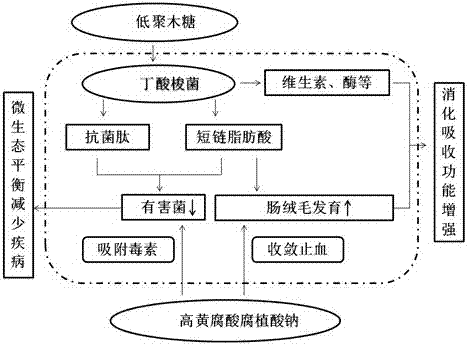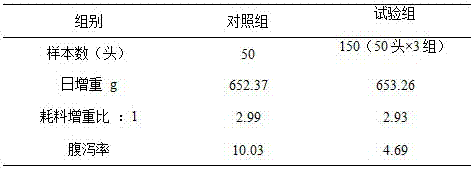Additive for synergetically promoting multiplication and colonization of intestinal probiotics and use method of additive
A technology of intestinal probiotics and additives, applied in application, additional food elements, animal feed, etc., to achieve the effect of shortening the lag period, improving the level of adhesion receptors, and strong competitiveness
- Summary
- Abstract
- Description
- Claims
- Application Information
AI Technical Summary
Problems solved by technology
Method used
Image
Examples
Embodiment 1
[0036] Embodiment 1: an additive for synergistically promoting the proliferation and colonization of intestinal probiotics, which is made of the following raw materials in parts by weight: 10-15 parts of xylooligosaccharides, 10-15 parts of Clostridium butyricum, High fulvic acid sodium humate 70-80 parts. The xylooligosaccharide refers to the content of xylooligosaccharide with a degree of polymerization of 2-4 is more than 55% (the product is produced by Shandong Longli Biotechnology Co., Ltd.). The content of fulvic acid in the high fulvic acid sodium humate is ≥12%. The number of live bacteria of Clostridium butyricum is 10 10 -10 11 Colonies / g.
[0037] Preparation of high fulvic acid sodium humate:
[0038] (1) Preparation of mycelia liquid: Phanerochaete chrysosporium (purchased from China Industrial Microorganism Culture Collection Management Center, No. CICC 40299, Phanerochaete chrysosporium ) was inoculated into the wort liquid medium, and cultured at 39 degree...
Embodiment 2
[0048] Embodiment 2: an additive for synergistically promoting the proliferation and colonization of intestinal probiotics, which is made of the following raw materials in parts by weight: 10-15 parts of xylooligosaccharides, 10-15 parts of Clostridium butyricum, High fulvic acid sodium humate 70-80 parts. The xylooligosaccharide refers to the content of xylooligosaccharide with a degree of polymerization of 2-4 is more than 55% (the product is produced by Shandong Longli Biotechnology Co., Ltd.). The content of fulvic acid in the high fulvic acid sodium humate is ≥12%. Preparation of high fulvic acid sodium humate:
[0049] (1) Preparation of mycelia liquid: Phanerochaete chrysosporium (purchased from China Industrial Microorganism Culture Collection Management Center, No. CICC 40299, Phanerochaete chrysosporium ) was inoculated into the wort liquid medium, and cultured at 39 degrees Celsius for 6 days to prepare the mycelia liquid.
[0050] (2) Mix the mycelia liquid, pur...
Embodiment 3
[0059] Embodiment 3: The similarities between this embodiment and Embodiment 2 will not be repeated, the difference is: the preparation of high fulvic acid sodium humate
[0060] (1) Preparation of mycelial liquid: Phanerochaete chrysosporium was inoculated into wort liquid culture medium, and cultured at 39 degrees Celsius for 8 days to prepare mycelial liquid.
[0061] (2) Mix the mycelia liquid, purified water and sodium humate (produced by Jinan Haihua Biotechnology Co., Ltd.) according to the weight of 3:2:4, and add inorganic salts (urea 0.3%, dipotassium hydrogen phosphate 0.5% according to the weight of the mixture) , potassium dihydrogen phosphate 0.5%, magnesium sulfate 0.3%, manganese sulfate 0.05%).
[0062] (3) The pH is controlled at 6.0, the temperature is 37 degrees Celsius, and the reaction is stirred at 60 rpm for 8 days.
[0063] (4) The reaction solution was dried by a drum to obtain a flake product with a fulvic acid content of 14.4%.
PUM
 Login to View More
Login to View More Abstract
Description
Claims
Application Information
 Login to View More
Login to View More - R&D
- Intellectual Property
- Life Sciences
- Materials
- Tech Scout
- Unparalleled Data Quality
- Higher Quality Content
- 60% Fewer Hallucinations
Browse by: Latest US Patents, China's latest patents, Technical Efficacy Thesaurus, Application Domain, Technology Topic, Popular Technical Reports.
© 2025 PatSnap. All rights reserved.Legal|Privacy policy|Modern Slavery Act Transparency Statement|Sitemap|About US| Contact US: help@patsnap.com



